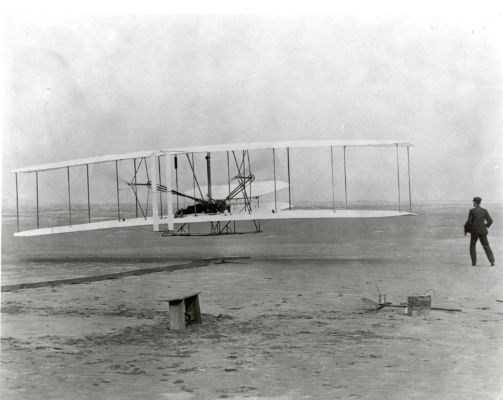Last updated: October 2, 2020
Lesson Plan
Transformations & First Flight

- Grade Level:
- Middle School: Sixth Grade through Eighth Grade
- Subject:
- Math
- Lesson Duration:
- 90 Minutes
- State Standards:
- N.C. 8.G.1: Verify experimentally the properties of rotations, reflections, and translation
Essential Question
Do the properties of translation, reflection and rotation apply to the Wright flyer?
Objective
The student will be able to:
a) translate in the coordinate plane
b) reflect in the coordinate plane
c) rotate in the coordinate plane
Background
Near Kitty Hawk, North Carolina, Orville and Wilbur Wright make the first successful flight in history of a self-propelled, heavier- than-air aircraft. Orville piloted the gasoline powered, propeller-driven biplane, which stayed aloft for 12 seconds and covered 120 feet on its inaugural flight.
Preparation
Share the following background information with students:
Near Kitty Hawk, North Carolina, Orville and Wilbur Wright make the first successful flight in history of a self-propelled, heavier- than-air aircraft. Orville piloted the gasoline powered, propeller-driven biplane, which stayed aloft for 12 seconds and covered 120 feet on its inaugural flight.
Materials
For this lesson student will need: Sidewalk chalk, Graph paper, Various recycled materials for creation of flyers, and Devices/Chromebooks. To download the full lesson plan, click the link below.
Procedure
1. Students will create a model of the Wright Flyer out of recycled materials using their creativity and modeling after the original flyer. Students will research the flyer to model it more accurately.
2. The flyer should be no more than 12” by 12”.
3. Students will create a coordinate plane with chalk outside on blacktop, labeling the x and y axis’, the origin, the quadrants and their signs, and the horizontal and vertical axis’ should be marked in equal increments.
4. Students will translate, reflect and rotate their flyers in the drawn coordinate planes based on the following rules:
a.) beginning at the origin translate 3 units up and 6 units to the right: record the new coordinates of the flyer and take a picture with device/Chromebook
b.) from previous location after translation, reflect the flyer over the y-axis and then again over the x-axis; record the new coordinates of the flyer and again take a picture with device.
c.) from previous location after reflection, rotate the flyer 90 degrees clockwise about the origin; record the new coordinates of the flyer and take a picture once again.
5. Describe the symmetry of the flyer.
Vocabulary
Translate - Translation refers to moving an object without changing it in any other way.
Reflect - A reflection is a kind of transformation. It is basically a 'flip' of a shape over the line of reflection
Rotate - Rotation of an object in two dimensions around a point O.
Coordinate Plane - A coordinate plane is an important tool for working with these equations. It is formed by a horizontal number line, called the x-axis, and a vertical number line, called the y-axis. The two axes intersect at a point called the origin.
Symmetry - Symmetry means that one shape becomes exactly like another when you move it in some way: turn, flip or slide. For two objects to be symmetrical, they must be the same size and shape, with one object having a different orientation from the first.
Assessment Materials
Students will be evaluated on each step and picture using a Rubric. Students will then describe how these mathematical concepts applied to the actual first flight and navigation.
https://mwsu.edu/academics/education/_assets/files/st/part-one/performancetaskrubric.pdf
Enrichment Activities
Create your own rules for translating, reflecting and rotating on your coordinate planes and have a peer model those rules with their flyer then switch. Evaluate each other.
Additional Resources
Websites:
https://www.ixl.com/math/
https://airandspace.si.edu/exhibitions/wright-brothers/online/fly/1903/triumph.cfm
https://www.loc.gov/item/today-in-history/december-17/
https://www.history.com/this-day-in-history/first-airplane-flies
Books:
The Bishop’s Boys: A Life of Wilbur and Orville Wright by Tom Crouch
